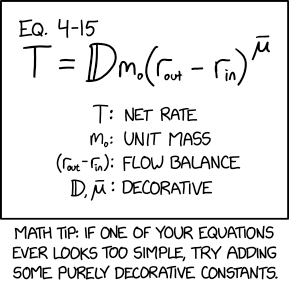2566: Decorative Constants
Explanation
| |
This explanation may be incomplete or incorrect: Created by a DECORATIVE BOT - Please change this comment when editing this page. Do NOT delete this tag too soon. If you can address this issue, please edit the page! Thanks. |
Transcript
- [A small panel only with text. Written as an excerpt from a mathematical text book. Begins with a number for an equation, then follows the equation written in larger letters and symbols. And below are explanations of each term in the equation.]
- Eq. 4-15
- T = Dm0(rout - rin)mu(bar)</subp</big>
- T: Net rate
- m0: Unit mass
- (rout-rin): Flow balance
- D, mu(bar): Decorative
- [Caption below the panel:]
- Math tip: if one of your equations ever looks too simple, try adding some purely decorative constants.
{{comic discussion}

